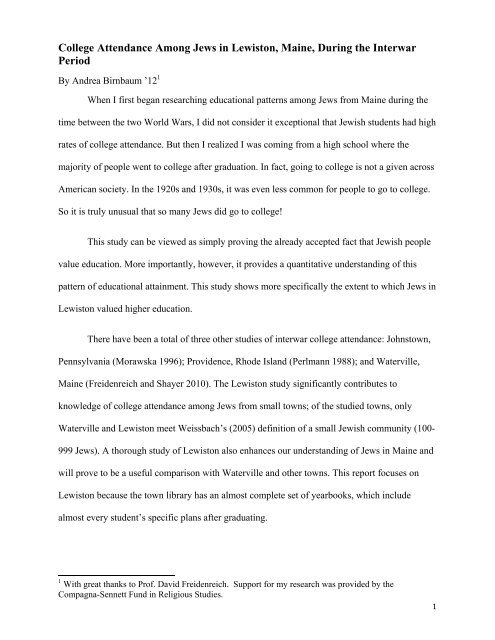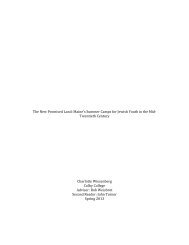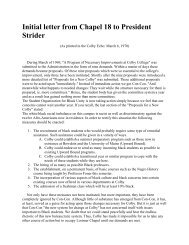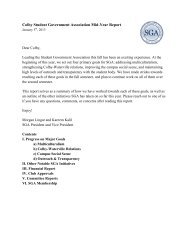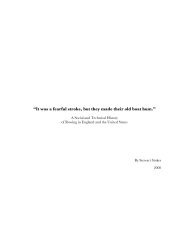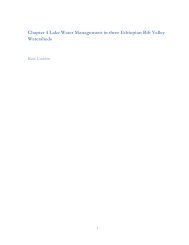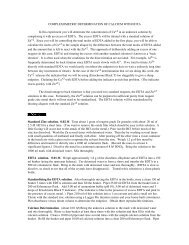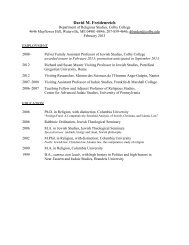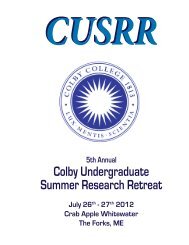College Attendance Among Jews in Lewiston, Maine, During the ...
College Attendance Among Jews in Lewiston, Maine, During the ...
College Attendance Among Jews in Lewiston, Maine, During the ...
You also want an ePaper? Increase the reach of your titles
YUMPU automatically turns print PDFs into web optimized ePapers that Google loves.
<strong>College</strong> <strong>Attendance</strong> <strong>Among</strong> <strong>Jews</strong> <strong>in</strong> <strong>Lewiston</strong>, Ma<strong>in</strong>e, Dur<strong>in</strong>g <strong>the</strong> Interwar<br />
Period<br />
By Andrea Birnbaum ’12 1<br />
When I first began research<strong>in</strong>g educational patterns among <strong>Jews</strong> from Ma<strong>in</strong>e dur<strong>in</strong>g <strong>the</strong><br />
time between <strong>the</strong> two World Wars, I did not consider it exceptional that Jewish students had high<br />
rates of college attendance. But <strong>the</strong>n I realized I was com<strong>in</strong>g from a high school where <strong>the</strong><br />
majority of people went to college after graduation. In fact, go<strong>in</strong>g to college is not a given across<br />
American society. In <strong>the</strong> 1920s and 1930s, it was even less common for people to go to college.<br />
So it is truly unusual that so many <strong>Jews</strong> did go to college!<br />
This study can be viewed as simply prov<strong>in</strong>g <strong>the</strong> already accepted fact that Jewish people<br />
value education. More importantly, however, it provides a quantitative understand<strong>in</strong>g of this<br />
pattern of educational atta<strong>in</strong>ment. This study shows more specifically <strong>the</strong> extent to which <strong>Jews</strong> <strong>in</strong><br />
<strong>Lewiston</strong> valued higher education.<br />
There have been a total of three o<strong>the</strong>r studies of <strong>in</strong>terwar college attendance: Johnstown,<br />
Pennsylvania (Morawska 1996); Providence, Rhode Island (Perlmann 1988); and Waterville,<br />
Ma<strong>in</strong>e (Freidenreich and Shayer 2010). The <strong>Lewiston</strong> study significantly contributes to<br />
knowledge of college attendance among <strong>Jews</strong> from small towns; of <strong>the</strong> studied towns, only<br />
Waterville and <strong>Lewiston</strong> meet Weissbach’s (2005) def<strong>in</strong>ition of a small Jewish community (100-<br />
999 <strong>Jews</strong>). A thorough study of <strong>Lewiston</strong> also enhances our understand<strong>in</strong>g of <strong>Jews</strong> <strong>in</strong> Ma<strong>in</strong>e and<br />
will prove to be a useful comparison with Waterville and o<strong>the</strong>r towns. This report focuses on<br />
<strong>Lewiston</strong> because <strong>the</strong> town library has an almost complete set of yearbooks, which <strong>in</strong>clude<br />
almost every student’s specific plans after graduat<strong>in</strong>g.<br />
1 With great thanks to Prof. David Freidenreich. Support for my research was provided by <strong>the</strong><br />
Compagna-Sennett Fund <strong>in</strong> Religious Studies.<br />
1
The first step <strong>in</strong> research<strong>in</strong>g this topic was to compile a complete list of <strong>the</strong> Jewish people<br />
who lived <strong>in</strong> <strong>Lewiston</strong> <strong>in</strong> 1930, us<strong>in</strong>g <strong>the</strong> 1930 census. Identify<strong>in</strong>g Jewish people took practice.<br />
Religion was not <strong>in</strong>cluded <strong>in</strong> <strong>the</strong> census, but <strong>the</strong> census did list country of orig<strong>in</strong> and language<br />
for those born abroad. In most cases, <strong>the</strong> <strong>Jews</strong> were from Russia, Poland, Lithuania or Germany.<br />
The census-takers often describe <strong>the</strong>ir language as Yiddish or Hebrew, but sometimes <strong>the</strong>y<br />
recorded <strong>the</strong> language as Russian or Polish. When <strong>the</strong> languages is denoted as such, it is possible<br />
that <strong>the</strong> people were Russian or Polish Christian immigrants, so to discern between <strong>the</strong> <strong>Jews</strong> and<br />
non-<strong>Jews</strong>, I also look at first names and occupation listed <strong>in</strong> <strong>the</strong> census. I <strong>the</strong>n exam<strong>in</strong>ed<br />
<strong>Lewiston</strong> High School yearbooks from <strong>the</strong> <strong>in</strong>terwar period, housed <strong>in</strong> <strong>the</strong> <strong>Lewiston</strong> Public<br />
Library. I collected <strong>in</strong>formation about <strong>the</strong> post-graduation plans of every student who graduated<br />
between 1927 and 1940, <strong>the</strong> period for which <strong>the</strong> library’s yearbook collection was<br />
comprehensive.<br />
Figure 1 is a representation of <strong>the</strong> college attendance rates of <strong>the</strong>se <strong>Lewiston</strong> High School<br />
graduates, Jewish and non-Jewish, male and female. This figure <strong>in</strong>troduces <strong>the</strong> disparity <strong>in</strong><br />
educational tendencies among Jewish and non-Jewish students.<br />
Figure 1. Source: <strong>Lewiston</strong> High School yearbooks. Out of a sample of 2,300 students, 73 were Jewish; <strong>Jews</strong><br />
comprised 3.2% of <strong>the</strong> student population.<br />
2
While Figure 1 represents students who graduated <strong>Lewiston</strong> High, Figure 2 demonstrates<br />
educational patterns among <strong>the</strong> general population <strong>in</strong> <strong>Lewiston</strong>. It is possible to study <strong>the</strong> percent<br />
of <strong>the</strong> population that is <strong>in</strong> school because <strong>the</strong> 1930 census-takers made note of every person who<br />
had been enrolled <strong>in</strong> school s<strong>in</strong>ce September 1929. Only about half of all <strong>Lewiston</strong> citizens of<br />
age 16-17 <strong>in</strong> 1930 attended school. School was only mandatory until age 16, and many of <strong>the</strong>se<br />
young people went to work <strong>in</strong> <strong>the</strong> mills <strong>in</strong>stead of f<strong>in</strong>ish<strong>in</strong>g high school. Although Joel<br />
Perlmann (1988) studied various ethnic groups <strong>in</strong> Providence, Rhode Island, he offers an<br />
explanation for <strong>the</strong> reason <strong>the</strong> <strong>Lewiston</strong> students went to work <strong>in</strong> <strong>the</strong> mills. Perlmann describes<br />
how Italian immigrants did not see <strong>the</strong> value <strong>in</strong> send<strong>in</strong>g <strong>the</strong>ir children to public school for longer<br />
than necessary when <strong>the</strong> children could be earn<strong>in</strong>g money for <strong>the</strong> family (84). A similar value<br />
system may have shaped <strong>the</strong> decisions of <strong>Lewiston</strong>’s large ethnic communities. Jewish young<br />
adults also often worked, but education was <strong>the</strong>ir families’ priority. As shown <strong>in</strong> Figure 2, all<br />
Jewish 16 and 17-year-olds <strong>in</strong> <strong>Lewiston</strong> <strong>in</strong> 1930 were <strong>in</strong> school, reflect<strong>in</strong>g how Jewish families<br />
placed value on f<strong>in</strong>ish<strong>in</strong>g high school.<br />
Figure 2. A statistical summary of <strong>the</strong> 1930 census gave <strong>the</strong> <strong>Lewiston</strong> school attendance rates for age categories 16-<br />
17 and 18-20, and I was able to calculate <strong>the</strong> equivalent rate us<strong>in</strong>g census data on <strong>Lewiston</strong>’s <strong>Jews</strong>.<br />
Figure 2 also <strong>in</strong>dicates that Jewish residents ages 18-20 were four times more likely to be<br />
students than <strong>the</strong>ir non-Jewish counterparts. When draw<strong>in</strong>g conclusions from this data, it is<br />
3
important to acknowledge that <strong>in</strong> 1930, some students graduated high school at age 18, while<br />
many o<strong>the</strong>rs graduated at ages 16 and 17. Therefore, school attendance rate among 18-20-year-<br />
olds does not directly correlate with <strong>the</strong> college attendance rates. Although <strong>the</strong> data is<br />
<strong>in</strong>determ<strong>in</strong>ate, <strong>the</strong> school attendance rates of <strong>Jews</strong> and non-<strong>Jews</strong> ages 18-20 are sufficiently<br />
different to provide evidence of major differences <strong>in</strong> <strong>the</strong> educational patterns with<strong>in</strong> <strong>the</strong>se<br />
populations.<br />
Figure 3 shows that <strong>in</strong> <strong>the</strong> time between 1927 and 1940 <strong>the</strong>re was little variance <strong>in</strong> <strong>the</strong><br />
Jewish college attendance rate. The overall average attendance rate of 62% is almost equivalent<br />
to <strong>the</strong> trend l<strong>in</strong>e, or <strong>the</strong> l<strong>in</strong>ear approximation. It is <strong>in</strong>terest<strong>in</strong>g that <strong>the</strong> college attendance rate did<br />
not <strong>in</strong>crease as time progressed, as this is what might have been expected. Because <strong>the</strong> variance<br />
<strong>in</strong> college attendance rate is not a function of <strong>the</strong> progress<strong>in</strong>g years, it is appropriate that this<br />
study analyzes all of <strong>the</strong> students from this time period <strong>in</strong> a s<strong>in</strong>gle data set.<br />
Figure 3. This data represents all of <strong>the</strong> Jewish students who graduated from 1927 through 1940 listed <strong>in</strong> <strong>the</strong><br />
yearbooks. I did not, however, rely exclusively on <strong>the</strong> yearbooks to calculate college attendance rates: I also used<br />
Bates <strong>College</strong> enrollment records. The overall average rate of 62% is higher than <strong>the</strong> averages that were obta<strong>in</strong>ed<br />
4
strictly from <strong>the</strong> yearbooks (see Figure 1) because some of <strong>the</strong> <strong>in</strong>dividuals who were not plann<strong>in</strong>g on attend<strong>in</strong>g<br />
college, accord<strong>in</strong>g to <strong>the</strong> yearbooks, did <strong>in</strong> fact attend Bates.<br />
Fur<strong>the</strong>r depth is added to <strong>the</strong> college attendance rates when compar<strong>in</strong>g <strong>the</strong> different types<br />
of schools that attracted different students. Jewish students had a proclivity towards 4-year<br />
liberal arts <strong>in</strong>stitutions such as Bates, Bowdo<strong>in</strong>, and <strong>the</strong> University of Ma<strong>in</strong>e. Figure 4 shows <strong>the</strong><br />
percentage, out of all <strong>the</strong> students pursu<strong>in</strong>g post-secondary education, who planned to attend 4-<br />
year <strong>in</strong>stitutions.<br />
Figure 4. The yearbooks only listed specific colleges for 93% of <strong>the</strong> students plann<strong>in</strong>g on attend<strong>in</strong>g post-secondary<br />
education; for <strong>the</strong> o<strong>the</strong>r 7% <strong>the</strong> yearbooks simply stated that <strong>the</strong>y would go to college. This graph reflects <strong>the</strong> 93%<br />
of students for whom we know <strong>the</strong>ir specific educational plans.<br />
Students pursu<strong>in</strong>g post-secondary education who did not enroll <strong>in</strong> 4-year schools would<br />
enroll <strong>in</strong> briefer professional programs; <strong>in</strong> addition, non-Jewish boys would often enter college-<br />
prep schools. Figures 5 and 6 show a breakdown of <strong>the</strong> different types of schools that female<br />
students attended. 2 Unlike <strong>the</strong>ir Jewish counterparts, most non-Jewish women went to teachers<br />
colleges, secretarial schools, and nurs<strong>in</strong>g schools. Even though Jewish women did not have high<br />
attendance rates at teachers colleges and secretarial schools, <strong>the</strong>y did pursue <strong>the</strong>se careers; <strong>the</strong>y<br />
often went to 4-year colleges to prepare for <strong>the</strong>se occupations. Consider, for example, Libby<br />
2 I chose to assess female students because almost all male Jewish students went to 4-year schools.<br />
5
Goldman, who grew up <strong>in</strong> <strong>Lewiston</strong>’s neighbor<strong>in</strong>g town of Auburn. “I always planned on be<strong>in</strong>g<br />
a teacher,” she recounted. Goldman, however, did not enroll <strong>in</strong> a teachers college like many of<br />
her non-Jewish peers but <strong>in</strong>stead attended Bates <strong>College</strong>, graduat<strong>in</strong>g <strong>in</strong> 1929 (Goldman 2010).<br />
Goldman’s experience reflects <strong>the</strong> fact that <strong>Jews</strong> from <strong>the</strong> <strong>Lewiston</strong> area were genu<strong>in</strong>ely<br />
attracted to 4-year college because <strong>the</strong>y valued <strong>the</strong> opportunities associated with a liberal arts<br />
education, even while <strong>the</strong> trend among <strong>Lewiston</strong>’s non-Jewish students was to enroll <strong>in</strong><br />
professional programs.<br />
Figure 5. Representative of 15 Jewish girls from <strong>Lewiston</strong> for whom <strong>the</strong> yearbooks provided a specific type of<br />
college. Just as <strong>the</strong> yearbooks <strong>in</strong>cluded specific types of schools for 93% of <strong>the</strong> students, <strong>the</strong> yearbooks also listed<br />
specific schools for 93% (15 out of 16) of <strong>the</strong> girls pursu<strong>in</strong>g higher education. <strong>Jews</strong> constitute 3.8% of all girls who<br />
pursued post-secondary education. Also note that <strong>the</strong> current version of Excel can not create pie graphs us<strong>in</strong>g<br />
percentages with decimal po<strong>in</strong>ts, and each pie graph must add to 100%; as a result, <strong>the</strong> accurate percent of girls<br />
attend<strong>in</strong>g art/music/design schools is 13%, or 2/15 girls.<br />
6
Figure 6. Representative of 377 non-Jewish girls from <strong>Lewiston</strong> for whom <strong>the</strong> yearbooks provided a specific type of<br />
college.<br />
More than a quarter of all non-Jewish girls pursu<strong>in</strong>g higher education went <strong>in</strong>to nurs<strong>in</strong>g,<br />
while only one Jewish girl went <strong>in</strong>to that field. This trend <strong>in</strong> <strong>Lewiston</strong> might be expla<strong>in</strong>ed with<br />
<strong>the</strong> knowledge that many hospitals <strong>in</strong> <strong>the</strong> United States <strong>in</strong> <strong>the</strong> early 20 th century were Christian<br />
and would limit <strong>the</strong>ir acceptance of Jewish students <strong>in</strong>to <strong>the</strong>ir nurs<strong>in</strong>g programs (Mayer 2009). It<br />
also was very difficult for Jewish nurses and doctors to f<strong>in</strong>d employment <strong>in</strong> <strong>the</strong>se hospitals.<br />
A clear explanation for <strong>the</strong> strik<strong>in</strong>g college attendance rates among <strong>Lewiston</strong> <strong>Jews</strong> is that<br />
<strong>the</strong> <strong>Lewiston</strong> <strong>Jews</strong> valued education, but it is also important to consider how family wealth might<br />
account for some of <strong>the</strong> differences <strong>in</strong> educational atta<strong>in</strong>ment. To view Jewish college attendance<br />
with<strong>in</strong> <strong>the</strong> context of <strong>Lewiston</strong>, it is important to compare <strong>the</strong> <strong>Jews</strong> and non-<strong>Jews</strong> economically.<br />
Figures 7 and 8, which show <strong>the</strong> median value of owned homes and <strong>the</strong> median monthly rent,<br />
suggest that Jewish households <strong>in</strong> <strong>Lewiston</strong> were significantly more well off than <strong>the</strong> general<br />
population <strong>in</strong> that city.<br />
7
Figure 7. The Jewish median was calculated us<strong>in</strong>g <strong>in</strong>formation on all Jewish families listed <strong>in</strong> <strong>the</strong> 1930 census. The<br />
summary of <strong>the</strong> census provided <strong>the</strong> <strong>Lewiston</strong> median.<br />
Figure 8. See note on Figure 7.<br />
Given this disparity <strong>in</strong> wealth between <strong>the</strong> Jewish community <strong>in</strong> <strong>Lewiston</strong> and <strong>the</strong><br />
<strong>Lewiston</strong> population at large, I sought to f<strong>in</strong>d <strong>the</strong> relationship between <strong>the</strong> values of owned and<br />
rented homes and <strong>the</strong> college attendance rate. In Figure 9, <strong>the</strong> Jewish students are separated <strong>in</strong>to<br />
four categories: students whose families owned or rented <strong>the</strong>ir homes for above or below <strong>the</strong><br />
median value of Jewish owned and rented homes <strong>in</strong> <strong>Lewiston</strong>. Jewish students whose families<br />
rented <strong>the</strong>ir homes for higher than <strong>the</strong> median monthly rent attended college more frequently<br />
than members of households whose rent is below <strong>the</strong> Jewish median. We do not know that<br />
Jewish families who paid a higher monthly rent were necessarily wealthier, but this statistic may<br />
8
suggest a correlation between family wealth and college attendance. On <strong>the</strong> contrary to what<br />
might be expected, students whose families owned <strong>the</strong>ir homes for less than <strong>the</strong> Jewish median<br />
value of owned homes went to college at a higher rate than those students whose families own<br />
more costly homes. Aga<strong>in</strong>, value of owned homes may or may not have related directly to family<br />
wealth. It is possible that families which valued sav<strong>in</strong>g and <strong>in</strong>vest<strong>in</strong>g <strong>in</strong> <strong>the</strong>ir children’s college<br />
education chose not to <strong>in</strong>vest <strong>in</strong> expensive homes. No solid conclusions can be made us<strong>in</strong>g this<br />
data, but if family wealth did correlate with <strong>the</strong> market value of owned and rented homes, <strong>the</strong>n<br />
<strong>the</strong> <strong>in</strong>consistency <strong>in</strong> <strong>the</strong> relationship between college attendance and home values suggests that<br />
differences <strong>in</strong> wealth with<strong>in</strong> <strong>the</strong> Jewish community did not greatly affect <strong>the</strong> rate of college<br />
attendance. Accept<strong>in</strong>g this logic, <strong>the</strong> primary “push factor” <strong>in</strong>fluenc<strong>in</strong>g <strong>the</strong>se students to go to<br />
college was not <strong>the</strong>ir family’s wealth. 3<br />
Figure 9. Divid<strong>in</strong>g families us<strong>in</strong>g <strong>the</strong> Jewish median shows variance with<strong>in</strong> <strong>the</strong> Jewish community and separates <strong>the</strong><br />
families <strong>in</strong>to four almost equally sized groups. If <strong>the</strong> sample size were larger, it would have been possible to separate<br />
<strong>the</strong> families us<strong>in</strong>g <strong>the</strong> <strong>Lewiston</strong> median, so as to show <strong>the</strong> families that were wealthy and poor relative to <strong>the</strong> city of<br />
<strong>Lewiston</strong>.<br />
Many Jewish families were considerably wealthy, but what I am learn<strong>in</strong>g through<br />
<strong>in</strong>terviews is that even <strong>the</strong> Jewish families without much disposable <strong>in</strong>come sent <strong>the</strong>ir children to<br />
3 To explore this topic fur<strong>the</strong>r, <strong>in</strong> <strong>the</strong> near future I will use <strong>the</strong> census to ga<strong>the</strong>r home ownership and rent<br />
values for <strong>the</strong> non-Jewish students who went to <strong>Lewiston</strong> High School.<br />
9
college. For example, Libby Goldman, from Auburn, recounted that she and her bro<strong>the</strong>rs each<br />
saved 10 cents a week grow<strong>in</strong>g up for <strong>the</strong> purpose of pay<strong>in</strong>g for college. Then, s<strong>in</strong>ce her fa<strong>the</strong>r<br />
did not have much money, her bro<strong>the</strong>rs decided to give her <strong>the</strong>ir sav<strong>in</strong>gs so that she could go to<br />
Bates because she was <strong>the</strong> smartest child (Goldman 2010). This is surpris<strong>in</strong>g: one might th<strong>in</strong>k<br />
that it would have been her fa<strong>the</strong>r that paid for her education. It is also evident that her family<br />
had little economic means because she received f<strong>in</strong>ancial aid. And like many of <strong>the</strong> Ma<strong>in</strong>e’s<br />
Jewish students who attended college <strong>in</strong>-state, Libby lived at home and commuted because her<br />
family could not afford room and board.<br />
Lester Jolovitz, who grew up <strong>in</strong> W<strong>in</strong>slow and graduated from Colby <strong>in</strong> 1939, reflects on<br />
his family’s f<strong>in</strong>ancial background:<br />
I th<strong>in</strong>k my first semester was $300. And I was able to live at home. My fa<strong>the</strong>r<br />
was, you know, a simple grocer, had one store, we had three or four people<br />
work<strong>in</strong>g <strong>in</strong> <strong>the</strong> store, but my fa<strong>the</strong>r made what we would call a sort of comfortable<br />
liv<strong>in</strong>g compared with <strong>the</strong> people that were our customers, because all of our<br />
customers were mill workers, and, you know, <strong>in</strong> those days a mill worker would<br />
make $25, $30 a week, and raise a family… my fa<strong>the</strong>r was <strong>in</strong> bus<strong>in</strong>ess and we<br />
were <strong>Jews</strong>, so we were always considered wealthy. (Jolovitz 2010)<br />
Figure 8 <strong>in</strong>dicates that <strong>Lewiston</strong>’s <strong>Jews</strong> were better off than <strong>the</strong> average <strong>Lewiston</strong><br />
residents, but as Goldman and Jolovitz describe, many <strong>Jews</strong> <strong>in</strong> Ma<strong>in</strong>e still lived humble lives. Аs<br />
Jolovitz implies, we must remember to abandon our baggage of Jewish stereotypes: <strong>the</strong> Jewish<br />
students <strong>in</strong> this study were not children of doctors and lawyers. If <strong>the</strong>y were, <strong>the</strong>se statistics<br />
would not be surpris<strong>in</strong>g. These students had immigrant parents who were shop owners and<br />
merchants. They were from middle class families. They lived more comfortably than <strong>the</strong><br />
majority of <strong>the</strong> town, and <strong>the</strong>ir college attendance rates demonstrate elite values, but <strong>the</strong>y were<br />
not <strong>the</strong> elite.<br />
10
Clearly, economics alone cannot account for <strong>the</strong> disparity <strong>in</strong> post-secondary education<br />
patterns among <strong>Jews</strong> and non-<strong>Jews</strong>. Here we turn aga<strong>in</strong> to <strong>the</strong> notion that Jewish people valued<br />
education. Different people have different sets of values, and <strong>the</strong> value system held by <strong>Jews</strong><br />
encouraged high rates of post-secondary education. An anecdote from an <strong>in</strong>terview with Lester<br />
Jolovitz evokes this Jewish po<strong>in</strong>t of view. When Jolovitz was asked if he was expected to take<br />
over his fa<strong>the</strong>r’s grocery store, he replied:<br />
First of all, I hated <strong>the</strong> bus<strong>in</strong>ess. From an early age, I decided this is not for me.<br />
And, I always, I don’t know why, I just knew that I would not end up work<strong>in</strong>g <strong>in</strong><br />
my fa<strong>the</strong>r’s store, or go <strong>in</strong>to <strong>the</strong> mill, as 99% of my friends did, go <strong>in</strong>to <strong>the</strong><br />
factory. I always had an idea <strong>the</strong>re was more to life…my parents <strong>in</strong>stilled <strong>in</strong> me<br />
and my bro<strong>the</strong>r that <strong>the</strong>re was more to… well, it was generally understood we’d<br />
go to college.<br />
What Jolovitz is describ<strong>in</strong>g is a value related to upward mobility, one that was not a typical value<br />
for his time. Jolovitz was <strong>the</strong> only Jewish boy <strong>in</strong> his high school class, and he was one of <strong>the</strong><br />
three <strong>in</strong> his graduat<strong>in</strong>g class of 60 to go to college because <strong>the</strong> majority of his classmates went to<br />
work <strong>in</strong> <strong>the</strong> factories and on <strong>the</strong> farms (Jolovitz 2010). In <strong>the</strong> context of his high school, Lester<br />
Jolovitz’s educational expectations were extraord<strong>in</strong>ary, but <strong>the</strong>y appear to be typical for <strong>Jews</strong> <strong>in</strong><br />
Ma<strong>in</strong>e.<br />
We can learn about <strong>the</strong> extent to which Jewish people valued education by view<strong>in</strong>g how<br />
several factors <strong>in</strong>fluenced a Jewish student’s probability of go<strong>in</strong>g to college. To beg<strong>in</strong>, <strong>the</strong><br />
number of children <strong>in</strong> <strong>the</strong> family was <strong>in</strong>fluential (Figure 10). Families with two children were<br />
<strong>the</strong> most likely to send <strong>the</strong>ir children to college. The college rate decreases cont<strong>in</strong>ually with<br />
additional children <strong>in</strong> <strong>the</strong> family, although households of three and four children still display<br />
high college attendance rates. The decl<strong>in</strong>e <strong>in</strong> college attendance rates could be because <strong>the</strong><br />
families with more children did not have <strong>the</strong> f<strong>in</strong>ancial resources to support each child through<br />
11
college. It also could be a matter of family plann<strong>in</strong>g, as it is possible that <strong>the</strong> families who had<br />
two children were more modern, plann<strong>in</strong>g for <strong>the</strong>ir children’s post-secondary education just as<br />
<strong>the</strong>y planned to have a family of four. Ano<strong>the</strong>r speculation is that <strong>the</strong> more children <strong>the</strong>re were <strong>in</strong><br />
a family, <strong>the</strong> more likely it was that at least one of <strong>the</strong>m would chose not to attend college. The<br />
college attendance rate among only-child students may be so low because of <strong>the</strong> small sample<br />
size (see caption).<br />
Families with two children provide an <strong>in</strong>terest<strong>in</strong>g case study, as we can perhaps learn<br />
about how <strong>the</strong>se families valued post-secondary education for each of <strong>the</strong>ir children. Out of <strong>the</strong><br />
seven families for whom we know <strong>the</strong> post-secondary plans for both children, four of <strong>the</strong><br />
families sent both children to college. Each of <strong>the</strong> rema<strong>in</strong><strong>in</strong>g three families sent only <strong>the</strong> first<br />
child to college. On that note, Figure 11 shows that birth order has a slight but significant impact<br />
on college attendance. Of <strong>the</strong> seven families with two children, <strong>the</strong>re were five families that had<br />
one child of each sex. Three of <strong>the</strong>m sent both <strong>the</strong> son and <strong>the</strong> daughter to school, one sent <strong>the</strong><br />
son but not <strong>the</strong> daughter, and <strong>the</strong> last sent <strong>the</strong> daughter but not <strong>the</strong> son. This admittedly small<br />
data set reflects <strong>the</strong> fact that Jewish parents often considered it important to send <strong>the</strong>ir daughters<br />
to college.<br />
12
Figure 10. The students represented <strong>in</strong> this sample were all found <strong>in</strong> <strong>the</strong> 1927–1940 yearbooks and <strong>the</strong> census, and<br />
<strong>the</strong>ir college attendance was ga<strong>the</strong>red us<strong>in</strong>g <strong>the</strong> yearbooks and Bates enrollment <strong>in</strong>formation. The census records<br />
listed <strong>the</strong> members of each household, and I used this <strong>in</strong>formation to determ<strong>in</strong>e <strong>the</strong> number of children <strong>in</strong> each<br />
family. (This calculation is subject to error because <strong>the</strong> oldest sibl<strong>in</strong>gs might have moved away and future children<br />
might not have been born yet <strong>in</strong> 1930). Note that this chart does not represent all sibl<strong>in</strong>gs <strong>in</strong> <strong>the</strong> each family, only<br />
those who graduated from 1927 to 1940. There were 6 students that were <strong>the</strong> only child, 17 who had 1 o<strong>the</strong>r sibl<strong>in</strong>g,<br />
23 who had 2 o<strong>the</strong>r sibl<strong>in</strong>gs, 11 who had 3 o<strong>the</strong>r sibl<strong>in</strong>gs, and 13 who had 4 o<strong>the</strong>r sibl<strong>in</strong>gs. This chart does not<br />
represent <strong>the</strong> 4 Jewish students <strong>in</strong> <strong>the</strong> yearbooks for whom <strong>the</strong>re was no census <strong>in</strong>formation available.<br />
Figure 11. The sample <strong>in</strong>cludes all of <strong>the</strong> Jewish students identified <strong>in</strong> <strong>the</strong> yearbooks between 1927 and 1940,<br />
identified as first-born us<strong>in</strong>g <strong>the</strong> census. Aga<strong>in</strong>, <strong>the</strong> yearbook was not <strong>the</strong> sole <strong>in</strong>dicator of post-secondary plans, <strong>the</strong><br />
Bates enrollment records also contributed. .<br />
This research sheds light upon <strong>the</strong> ways Ma<strong>in</strong>e <strong>Jews</strong> saw <strong>the</strong> relationship between gender<br />
and extended education. Look<strong>in</strong>g back at Figure 1, Jewish boys had a college attendance rate of<br />
57%, while Jewish girls went at a rate of 52%. These rates are very similar. As mentioned<br />
previously, Libby Goldman’s bro<strong>the</strong>rs gave her <strong>the</strong>ir childhood sav<strong>in</strong>gs so that she may go to<br />
Bates. The way <strong>the</strong>se bro<strong>the</strong>rs appropriated <strong>the</strong>ir resources shows that <strong>the</strong>y value post-secondary<br />
education for girls. Jewish parents <strong>in</strong> <strong>Lewiston</strong> who sent <strong>the</strong>ir daughters to college must have<br />
seen <strong>the</strong> fur<strong>the</strong>r education as a worthwhile <strong>in</strong>vestment.<br />
This study is situated <strong>in</strong> an ongo<strong>in</strong>g debate <strong>in</strong> <strong>the</strong> field of Jewish Studies over <strong>the</strong> extent<br />
to which <strong>Jews</strong> are exceptional and <strong>the</strong> reasons for such exceptionalism. Jewish college<br />
attendance <strong>in</strong> Ma<strong>in</strong>e dur<strong>in</strong>g <strong>the</strong> <strong>in</strong>terwar period is undoubtedly exceptional. Cultural differences<br />
are very real, and different ethnic groups respond to challenges, such as prepar<strong>in</strong>g one’s children<br />
13
for <strong>the</strong> future, <strong>in</strong> different ways. <strong>Jews</strong> were wealthier than o<strong>the</strong>rs, and this most certa<strong>in</strong>ly made it<br />
easier for <strong>the</strong>m to sacrifice <strong>the</strong> f<strong>in</strong>ancial resources and <strong>the</strong> time for fur<strong>the</strong>r education. However,<br />
family wealth did not make Jewish parents decide to send <strong>the</strong>ir children to college; <strong>the</strong>y did so<br />
because of a m<strong>in</strong>dset. This ethos of valu<strong>in</strong>g post-secondary education was sparse among <strong>the</strong><br />
general population <strong>in</strong> <strong>Lewiston</strong> dur<strong>in</strong>g this time; it was a worldview that came from with<strong>in</strong> <strong>the</strong><br />
Jewish community.<br />
14
Works Cited<br />
Freidenreich, David, and Desiree Shayer. “A Tale of Two <strong>College</strong>s: <strong>Jews</strong> and Ma<strong>in</strong>e’s Baptist<br />
Institutions dur<strong>in</strong>g <strong>the</strong> Interwar Years.” Presented at <strong>the</strong> annual meet<strong>in</strong>g of <strong>the</strong><br />
Association for Jewish Studies, Dec. 21, 2010. Colby’s Ma<strong>in</strong>e Jewish History Project<br />
.<br />
Goldman, Libby. Personal Interview. Conducted by David Freidenreich. Nov. 11, 2010.<br />
Jolovitz, Lester. Personal Interview. Conducted by Sam Lev<strong>in</strong>e. Jan. 10, 2010.<br />
Mayer, Susan L.. "Nurs<strong>in</strong>g <strong>in</strong> <strong>the</strong> United States." Jewish Women: A Comprehensive Historical<br />
Encyclopedia. 2009. Jewish Women's Archive. August 7, 2011<br />
.<br />
Morawska, Ewa T. Insecure Prosperity: Small-town <strong>Jews</strong> <strong>in</strong> Industrial America, 1890-1940.<br />
Pr<strong>in</strong>ceton, N.J: Pr<strong>in</strong>ceton University Press, 1996. Pr<strong>in</strong>t.<br />
Perlmann, Joel. Ethnic Differences: School<strong>in</strong>g and Social Structure <strong>Among</strong> <strong>the</strong> Irish, Italians,<br />
<strong>Jews</strong>, and Blacks <strong>in</strong> an American City, 1880-1935. Cambridge: Cambridge University<br />
Press, 1988. Pr<strong>in</strong>t.<br />
Weissbach, Lee S. Jewish Life <strong>in</strong> Small-Town America: A History. New Haven: Yale University<br />
Press, 2005. Pr<strong>in</strong>t.<br />
15


